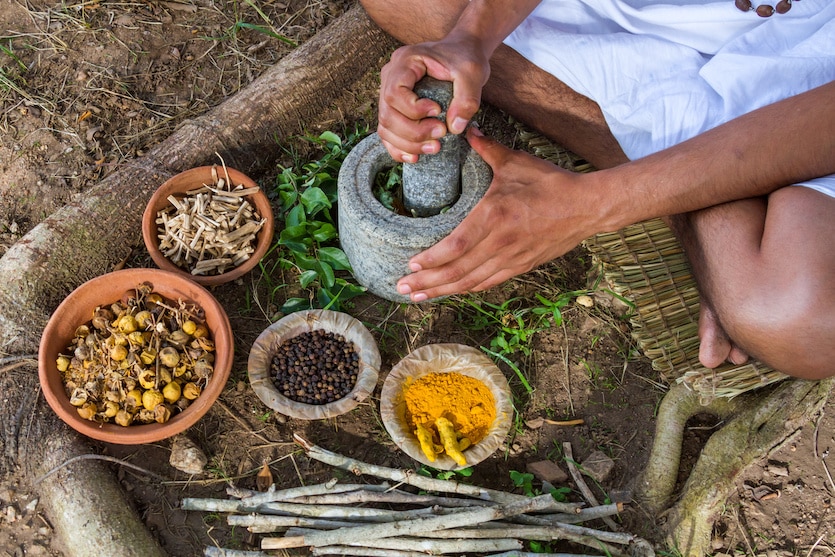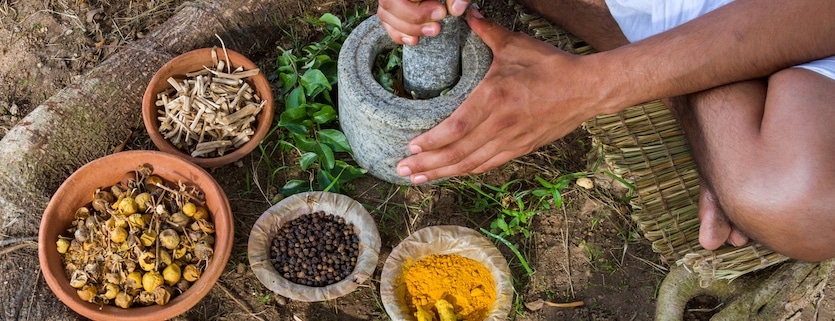What is Ayurveda? Learn the Main Practices of This Traditional Indian Medicine

The human body is a complicated system, to say the least. And for thousands of years, various cultures and societies have developed their own understandings of the human body and how to treat its various illnesses and ailments. One of the oldest existing examples of these treatment systems is Ayurveda (also called Ayurvedic medicine), a form of traditional medicine originally developed in South Asia.
Whether you’re learning about Ayurveda for the first time or simply looking for more information on the subject, don’t worry—you’re in the right place. This article will break down the history of Ayurveda, its common practices, and more.
What is Ayurveda?
As mentioned above, Ayurveda, or ayurvedic medicine, is a form of traditional medicine with its roots in South Asia—more specifically, the Indian subcontinent. Based on the age of various ayurvedic texts, Ayurveda as a practice is about two thousand years old, though many aspects of it may have existed before these records.
The word Ayurveda is a combination of two Sanskrit words: ayur, meaning life, and veda, meaning knowledge. Together, they mean “knowledge of life”. These etymological roots are actually a great starting point for understanding Ayurveda as a medicinal system. Ayurveda is not focused simply on treating illnesses, but on implementing lifestyle changes that help prevent illness, promote bodily, mental, and spiritual balance, and help keep you in tune with your environment.
If you’re wondering how medicines can accomplish all of that, there’s an easy answer: they can’t. But ayurvedic treatments are composed of much more than medicine. While medicinal herbs and other ingested medicines play a part in the ayurvedic practice, they are one piece of a larger puzzle that includes practices like yoga, meditation, massage therapy, and dietary adjustments.
The sections below break down the foundations of ayurvedic treatment and some of the most common practices in ayurvedic medicine.
The History of Ayurvedic Medicine: The Three Doshas
According to Ayurveda, human beings are made up of five elements: water, earth, fire, space, and air. These elements combine in the human body to form three distinct energies or life forces: the Vata dosha, which is made of space and air; the Kapha dosha, made of water and earth; and, finally, the Pitta dosha, which is made up of fire and water.
Everyone has these three doshas within them, but to different degrees. That is, no two people have the same balance of each dosha. Each dosha is linked to various bodily functions and any ailment is thought to stem from imbalances between the doshas. As such, ayurvedic medicine seeks, in part, to address imbalances between the three doshas. But more on that later!
Common Practices of Ayurveda: Treating the Mind, Body, and Spirit
Ayurveda is a holistic approach to medicine, meaning its practices span all aspects of life. It’s not simply focused on a series of diagnoses and cures, but rather on the interconnected nature of each aspect of a person’s life. Unfortunately, that means that ayurvedic practices and treatments are numerous and varied—there’s no quick and easy way to become an expert. But here’s the good news: we’ve broken down some of the most common elements of ayurvedic treatment for you. Just read the list below!
- Panchakarma: As mentioned above, ayurvedic medicine is all about balance in your body, mind, and spirit. One of the most common methods for achieving bodily balance in Ayurveda is panchakarma, a process thought to help cleanse the body of waste material. Panchakarma, which typically takes between two and four weeks to complete, involves several purging processes including massage, enemas, dietary adjustments, and sometimes vomiting.
Followers of ayurvedic medicine undergo this process under the supervision of professional Ayurveda practitioners, often at a retreat or, in India, a hospital. - Massage: The body can harbor a lot of stress, mentally and physically. In Ayurveda, these reserves of stress are thought to throw off your mental and physical balance. Ayurvedic massage seeks to relieve and release physical and mental tension to help restore balance to your body. During this process, a massage therapist trained in Ayurveda massages the body with various oils and herbal ointments to release the tensions harbored in the body.
- Yoga: Although yoga is not an official element of ayurvedic treatment, it is often used as a complementary system in coordination with Ayurveda. Both Ayurveda and yoga have existed in India for thousands of years and both value physical and mental balance. The meditative nature of yoga calms the mind, while the physicality of it strengthens the body—both help achieve similar goals to ayurvedic treatment.
- Meditation: The primary goal of meditation—in virtually any context—is to clear the mind. This is also true in ayurvedic medicine, where meditation is used to establish and maintain mental and spiritual balance. Ayurvedic meditation is distinct, however, in its use of mantras to address specific dosha imbalances. These mantras, which change from person to person and from dosha to dosha, are chanted as part of meditation to help restore balance between the three doshas.
- Herbal medicine: Ayurveda is best known for its herbal remedies and for good reason. Ayurvedic herbal medicine is, in a way, the backbone of Ayurveda and is practiced throughout India—and, in recent years, the rest of the world. As mentioned above, in Ayurveda various ailments are associated with imbalanced doshas. Traditionally, a variety of herbs and plants have been used to address those imbalances. Some of the most common herbs and plants used are ashwagandha, which is thought to reduce stress, boswellia, which is used to reduce inflammation, and brahmi, which is also thought to reduce inflammation and stress. Additionally, common spices such as cumin, turmeric, and cardamom feature prominently in ayurvedic medicine.
Ayurvedic Practices: It’s Not All or Nothing
As traditional medicines grow in popularity around the world, they are being adopted in a wide variety of ways. Frequently, this means using traditional medicines in coordination with other treatment methods. If Ayurveda interests you, remember that it is not all or nothing. That is, Ayurveda doesn’t need to replace whatever medicinal system you are using. Instead, see if you can use the two in coordination for a more holistic approach to your health. If you are feeling stressed, maybe go for an ayurvedic massage. Take it one piece at a time and see what works for you.
References
https://www.ncbi.nlm.nih.gov/pmc/articles/PMC5198827/
https://www.betterhealth.vic.gov.au/health/conditionsandtreatments/ayurveda
https://www.medicalnewstoday.com/articles/ayurvedic-herbs#cardamom
https://www.hopkinsmedicine.org/health/wellness-and-prevention/ayurveda
https://www.healthline.com/nutrition/ayurvedic-herbs
https://vedanet.com/meditation-in-yoga-and-ayurveda/





